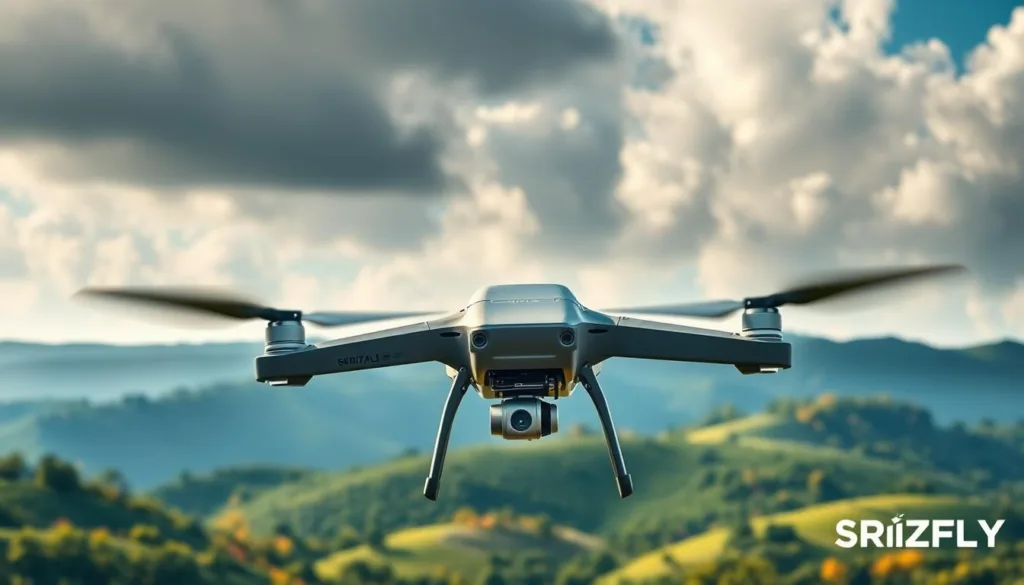85% of professional UAV programs report faster skill acquisition after adding simulator training to their curriculum — a striking indicator that realistic practice matters. This is why a reliable quadcopter drone simulator is now essential for operators who must train quickly, safely, and cost-effectively.
Simulators let teams log hours in poor weather, reduce risk to people and equipment, and cut material costs. Market-proven tools like Zephyr Drone Training Simulator, DRL Simulator, and DJI Flight Simulator show the demand for high-fidelity drone flight simulator environments. Data shows simulator training reduces real-world training time and improves safety metrics across industries.
We developed the SRIZFLY SESP-U1 to meet that demand. SRIZFLY delivers a systematic, highly simulated platform for UAV training that blends advanced physics, enterprise scenarios, and flexible pricing. Our simulator stands out with its feature set and a risk-free 10-day free trial so you can evaluate training efficiency and safety improvements firsthand.
We serve tower inspection, mapping, logistics, agriculture, training institutions, regional distributors, and government agencies such as emergency rescue and urban management. Your success drives us forward — test SRIZFLY and see measurable gains in training efficiency and operational readiness.
Key Takeaways
- SRIZFLY SESP-U1 is built for professional quadcopter drone simulator training across industries.
- Simulator training reduces real-world hours, lowers costs, and improves safety.
- SRIZFLY combines realistic physics, enterprise scenarios, and flexible pricing.
- A 10-day free trial removes buyer risk and demonstrates measurable efficiency gains.
- Ideal for UAV training programs in inspection, mapping, logistics, agriculture, and public sector use.
Overview of SRIZFLY SESP-U1 Drone Simulator
We present SRIZFLY SESP-U1 as a purpose-built quadcopter drone simulator for enterprise teams and training institutions. The platform focuses on mission-driven learning and replicates real flight behavior so operators gain transferable skills. Your organization can run certificate-ready curricula and log hours without risking hardware.
What Makes SRIZFLY Stand Out?
SRIZFLY is independently developed for professional use and centers on enterprise-level scenarios. It offers a mission library with industry-focused modules for power line inspection, emergency response, agriculture, and public safety.
We bundle training continuity with flexible pricing and a 10-day free trial to lower adoption barriers. Unlike consumer options such as DRL or VelociDrone, this drone flight simulator emphasizes certificate-ready training and instructor-managed sessions.
Key Features of the Simulator
The simulator includes step-by-step lessons, drills, and assessments to measure operator competency. Realistic physics and aircraft customization deliver close-to-real handling so pilots transfer skills quickly from sim to field.
Support exists for controller binding, instructor modes, VR or desktop access, and integrations like AirSim and Pixhawk for precise UAV behavior. Data-driven analytics provide logs, performance metrics, and exportable reports for institutional record keeping.
For a deeper look at enterprise capabilities and industry applications, review the SRIZFLY enterprise overview here: SRIZFLY enterprise-level drone simulator.
System Requirements for Optimal Performance
We recommend a modern Windows workstation with a mid-to-high range CPU and a dedicated GPU to ensure stable frame rates and high visual fidelity. Aim for 16+ GB RAM for demanding mission sets.
Minimum setups can run basic scenarios with a capable CPU, discrete GPU, and 8–16 GB RAM. Network infrastructure and remote control binding are necessary for multiplayer or multi-station training.
| Category | Minimum | Recommended |
|---|---|---|
| CPU | Quad-core modern CPU | Mid-to-high range 6+ core CPU |
| GPU | Discrete GPU with 2–4 GB VRAM | Dedicated GPU with 6+ GB VRAM |
| RAM | 8–16 GB | 16+ GB |
| Storage | SSD recommended, 20+ GB free | NVMe SSD, 50+ GB free |
| Peripherals | Standard RC controller or gamepad | Professional radio, VR headset optional |
| Integration | Local log export | AirSim, Pixhawk support and networked training |
For technical specs, platform compatibility, and a DJI-recognized enterprise option, see the trusted simulator overview: SRIZFLY SESP-U1 trusted quadcopter simulator. This supports enterprise adoption and highlights innovation in professional-grade simulators.
Comprehensive Training Scenarios Offered
We design a learning path that fits new pilots and seasoned teams. Our quadcopter drone simulator training mixes progressive drills with mission-style workflows. Trainees build confidence fast through structured lessons and measurable outcomes.

Basic Flight Training Modules
Basic flight training covers yaw, pitch, roll and throttle control in short, focused lessons. Takeoff, hover, and landing exercises teach safe routines. Waypoint navigation and return-to-home drills reinforce planning and situational awareness.
We match controller binding and radio profiles so muscle memory transfers to real hardware. Step-by-step lessons mirror practices in top FPV platforms and professional simulators. Assessment tools give pass/fail benchmarks and analytics to track progress.
Specialized Missions for Different Industries
Enterprise scenarios simulate tower inspection, power line surveys, oil and gas site checks, and agricultural spraying. Mapping and photogrammetry flights reproduce field workflows and data capture requirements.
Scenarios include constrained corridors, GPS-denied zones, and precise flightlines to improve data quality. Trainees learn mission planning, sensor operation, and post-flight review. These simulators reduce time in the field and standardize skills across teams.
Explore detailed module descriptions and trial options on SRIZFLY by visiting our training overview page: SRIZFLY simulator programs.
Emergency Response Training and Simulations
Emergency rescue simulation modules focus on search-and-rescue, disaster mapping, and fire-support sorties. Scenarios stress rapid deployment, low-altitude precision, and payload handling such as thermal sensors and drops.
Complex drills scale to multi-operator coordination for public safety and government units. Repeated practice in the simulator builds mission-critical skills without risking aircraft or personnel. This approach raises readiness for high-stress real-world operations.
Benefits of Using a Quadcopter Drone Simulator
We present practical benefits of a quadcopter drone simulator for training teams and individual pilots. Short training cycles, clear metrics, and repeatable scenarios make learning faster and more reliable. Below we break down how simulation improves skills, reduces costs, and raises safety standards for operators across industries.

Enhanced skill development starts with structured practice. A drone flight simulator offers staged modules that reinforce core maneuvers. Trainees build muscle memory and decision-making skills through repeated drills. Flight dynamics that match real hardware help pilots transfer control from virtual to real craft with fewer surprises.
Performance analytics make progress measurable. We can track error rates, task completion time, and mission accuracy. Instructors use this data to certify readiness and tailor lessons to weak points. Reports show faster competency gains than unstructured field practice, improving overall training efficiency.
Simulation cuts direct operating expenses. Virtual hours replace many live flights that wear airframes and consume batteries or fuel. Training cost savings include fewer repairs, less instructor travel, and smaller insurance exposure. Organizations can scale learning without proportional increases in field resources.
Running a drone flight simulator reduces the need to stage costly field exercises. Complex scenarios—urban inspections, crop surveys, or infrastructure checks—can be rehearsed in software before any real deployment. This lowers per-hour training cost and shortens the path from novice to certified operator.
Safety gains are immediate and measurable. High-risk maneuvers and emergency procedures can be practiced without endangering people or property. Teams rehearse payload drops, BVLOS contingencies, and loss-of-link responses in controlled settings to build confidence and reduce incident rates.
Simulation supports training in adverse conditions that would be unsafe or impossible in real life. Pilots can learn to operate in gusty wind, low visibility, or disaster zones without exposing equipment to damage. Repeated emergency drills improve coordination and decision-making while maintaining equipment readiness.
SRIZFLY’s SESP-U1 brings all of these benefits together. The platform emphasizes realism, analytics, and modular scenarios to maximize safety and efficiency. A 10-day free trial lets organizations evaluate training cost savings and quantify ROI before purchase.
| Benefit | What the Simulator Delivers | Impact |
|---|---|---|
| Skill Development | Staged modules, realistic physics, hardware binding | Faster pilot competency and better mission outcomes |
| Performance Analytics | Error tracking, time-to-task, custom reports | Objective certification and targeted coaching |
| Training Cost Savings | Reduced flight hours, fewer repairs, lower travel | Lower per-hour training expense and higher throughput |
| Safety | Emergency drills, hazardous-condition rehearsal | Fewer accidents and protected people and assets |
| Operational Efficiency | Repeatable scenarios, quick iteration, team drills | Improved mission readiness and resource allocation |
| Risk-Free Evaluation | 10-day free trial with full features | Quantify ROI before procurement |
Conclusion: Why Choose SRIZFLY SESP-U1?
We built SRIZFLY SESP-U1 as a professional-grade quadcopter drone simulator for enterprise and institutional training. The platform combines realistic physics, clear graphics, and structured curricula to drive measurable gains in efficiency and safety. Its enterprise focus and in-house R&D deliver repeatable mission readiness across inspections, public safety, agriculture, surveying, and oil and gas checks.
Summary of Key Takeaways
SRIZFLY SESP-U1 offers a broad, industry-aligned scenario library that covers basic flight modules and specialized missions like powerline inspection, emergency rescue, and firefighting. The system emphasizes repeatability and analytics, so teams can standardize procedures and track skill transfer. Pricing flexibility, long-term support, and core IP ownership let organizations adapt quickly as needs change.
Additional Resources for Drone Operators
For complementary practice, use established simulators such as DRL Simulator, VelociDrone, and FPV.SkyDive to hone racing or freestyle skills. Follow FAA guidance and industry training standards to align simulator logs with certification and continuous professional development. If you need custom scenarios, we partner with teams to reflect real operational terrain and procedures—see this enterprise overview for details: SRIZFLY enterprise missions.
How to Get Started with SRIZFLY SESP-U1
Step 1: Evaluate mission needs and hardware compatibility. Step 2: Try the 10-day free trial to validate controller binding, scenario fit, and reporting tools in your environment. Step 3: Deploy on recommended workstations, enroll trainees in structured modules, and use performance analytics to measure ROI. We are committed to delivering innovative drone flight simulator solutions that improve training efficiency, boost safety, and produce mission-ready operators.
FAQ
What is the SRIZFLY SESP-U1 and who is it designed for?
The SRIZFLY SESP-U1 is a professional quadcopter drone simulator built for enterprise and institutional training. We developed it to serve tower inspection teams, mapping and surveying firms, logistics and payload operators, agricultural sprayers, drone education centers, regional distributors, and government/public sectors such as emergency rescue and urban management. It focuses on mission-driven, certificate-ready training rather than recreational racing or freestyle practice.
Why use a simulator instead of only real-aircraft training?
Simulators let teams log flight hours in poor weather and high-risk scenarios without endangering people or equipment. They reduce consumable and operational costs, lower the chance of damaged airframes, and permit repeated practice of emergency procedures. Industry data show simulator training cuts real-world training time and material expense while improving safety and operator readiness.
How does SESP-U1 compare to consumer simulators like DRL Simulator, DJI Flight Simulator, or VelociDrone?
Compared with consumer-focused platforms, SESP-U1 emphasizes enterprise mission scenarios, industry-aligned curricula, and certificate-ready assessments. While DRL, DJI, VelociDrone, and FPV.SkyDive excel at racing or general flight dynamics, SESP-U1 provides high-fidelity physics plus scenario libraries tailored to inspections, surveying, public safety, and logistics—paired with analytics and instructor management for organizational training.
What are the standout features of the SESP-U1?
Standout features include an enterprise-level mission scenario library, structured curriculum with lessons and assessments, realistic flight physics and aircraft customization, controller/radio binding, instructor modes for centralized training, and data-driven analytics that export training logs and performance reports. We also offer flexible pricing and a 10-day free trial to remove procurement risk.
Which industry scenarios does the simulator include?
SESP-U1 includes scenarios for power line and tower inspection, oil and gas facility inspection, surveying and mapping (photogrammetry flightlines), agricultural plant protection and spraying route planning, aerial photography for media and inspection, logistics and payload delivery drills, plus public safety and emergency rescue missions such as search-and-rescue, firefighting support, and disaster-response mapping.
What basic flight skills and training modules are provided?
The simulator covers foundational skills: yaw, pitch, roll, throttle control, hover, takeoff and landing, waypoint navigation, return-to-home procedures, and progressive drills. Lessons are modular and build muscle memory through controller binding and hardware-matched setups. Assessment tools offer pass/fail benchmarks and objective performance analytics.
How does SESP-U1 support emergency response and multi-operator drills?
SESP-U1 provides high-stress scenarios for rapid deployment, low-altitude precision flying, payload operations (thermal imaging, drops), and coordination with ground teams. Scenario complexity scales to multi-operator coordination, enabling joint-response practice without exposing people or assets to real-world hazards.
What system requirements are needed to run SESP-U1 effectively?
For enterprise deployments we recommend modern Windows workstations with a mid-to-high-range CPU, a dedicated GPU, and 16+ GB RAM for best visual fidelity and stable frame rates. Minimum setups should have a capable CPU, discrete GPU, and 8–16 GB RAM depending on scenario complexity. Ensure network infrastructure and remote control binding support for multiplayer or multi-station training.
Can SESP-U1 integrate with institutional record-keeping and export training data?
Yes. SESP-U1 supports export and import of training logs and performance reports to integrate with institutional record-keeping. Analytics provide objective metrics—error rates, time-to-task, and competency tracking—that training managers can use to quantify readiness and ROI.
How does simulator training translate to real-world skill improvements?
Realistic physics and hardware binding improve skill transfer by replicating quadcopter behavior and controller feel. Structured modules and repetitive drills accelerate muscle-memory and decision-making. Industry comparisons and tests show measurable improvements in piloting accuracy, mission completion time, and reduced error rates when teams use professional simulators alongside field practice.
Is SESP-U1 cost-effective compared with live training?
Yes. Simulation reduces field hours, travel, consumables, and crash-related repair costs. Organizations can log many virtual hours at a fraction of real-world expense. The wide scenario variety also eliminates many staged field exercises, and the 10-day free trial lets teams validate ROI before purchase.
What safety benefits does the SESP-U1 offer?
The simulator enables safe rehearsal of high-risk maneuvers, emergency procedures, and payload operations. Teams can practice in adverse or dangerous conditions—poor weather, disaster zones, GPS-denied environments—without putting people or equipment at risk. Repeated emergency drills also enhance team coordination and reduce human error in real missions.
How can organizations test SESP-U1 before buying?
We offer a 10-day free trial designed for enterprise evaluation. During the trial, organizations can run core scenarios, test controller binding and instructor modes, and export analytics to assess training efficiency, performance improvements, and integration with existing systems.
Can SRIZFLY customize scenarios to match unique operational environments?
Yes. SRIZFLY supports partnerships for customized scenario development to mirror specific operational sites and workflows. Custom scenarios help standardize training across distributed teams and ensure mission relevance for specialized industries like oil and gas, utilities, and emergency services.
What support is available for deployment and instructor management?
We provide deployment guidance for recommended hardware, instructor-mode features for centralized training management, and documentation for controller binding and network setup. Additional support options include custom scenario development and integration assistance to align the simulator with institutional training programs.
Which complementary simulators or tools do you recommend for broader skills training?
For supplementary practice, using consumer and racing-focused simulators like DRL Simulator, VelociDrone, and FPV.SkyDive can round out freestyle or racing skills. These tools complement SESP-U1’s mission-driven training by sharpening reflexes and FPV handling where needed.
How does SRIZFLY demonstrate effectiveness—are there any performance metrics?
SRIZFLY emphasizes data-driven training analytics: logs, pass/fail benchmarks, error rates, and time-to-task metrics. Organizations using professional simulators typically report measurable efficiency gains—reduced field training hours and lower incident rates. We provide analytics during the trial so you can quantify improvements in your environment.
How do we get started with a trial and deployment?
Begin by evaluating primary mission types and hardware compatibility. Sign up for the 10-day free trial to validate scenarios, controller binding, and reporting. Deploy SESP-U1 on recommended workstations, enroll trainees in structured modules, and collect analytics to measure ROI. Contact SRIZFLY for custom scenario requests or enterprise pricing.



